ITFI Assignment: Financial Markets, Trade, and BRICS Economies
VerifiedAdded on 2023/01/19
|15
|4220
|32
Report
AI Summary
This report delves into the intricate relationship between financial markets and international trade, examining their significance in both domestic and global contexts. It explores the background of financial markets, including the impact of the 2008 financial crisis, and analyzes capital allocation within the UK economy, covering the roles of the banking system, domestic money market, and stock markets. The report further examines the international economy, detailing international capital markets, including commercial banks, bond markets, foreign exchange markets, and derivatives. A significant portion of the report is dedicated to understanding the challenges faced by developing economies, particularly focusing on the BRICS nations and analyzing the Chinese economy through factors like production/manufacturing, inflation, and employment, as well as the challenges posed by industrialization and trade policies set by the WTO. The report concludes with a synthesis of the key findings and implications for future economic development.
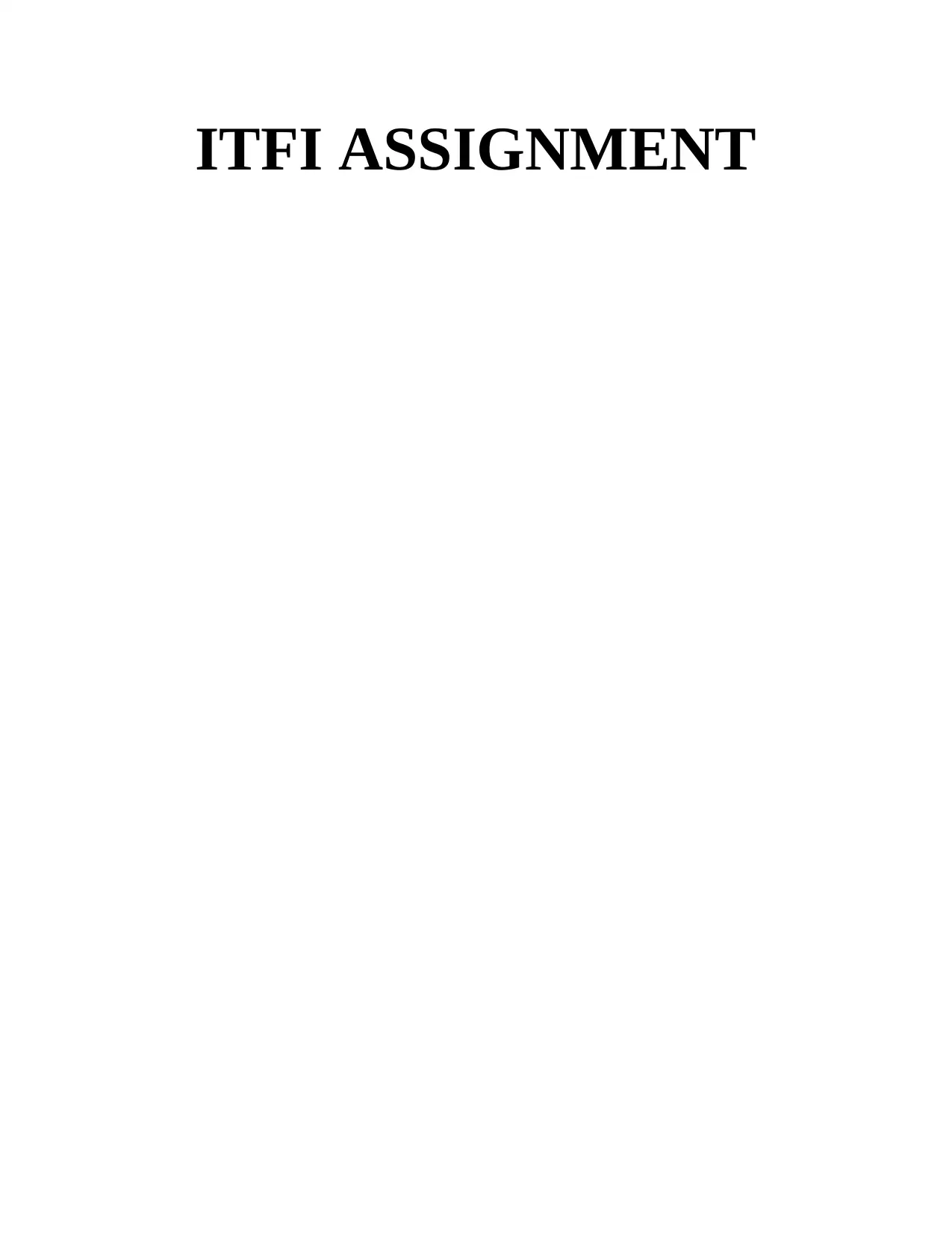
ITFI ASSIGNMENT
Paraphrase This Document
Need a fresh take? Get an instant paraphrase of this document with our AI Paraphraser
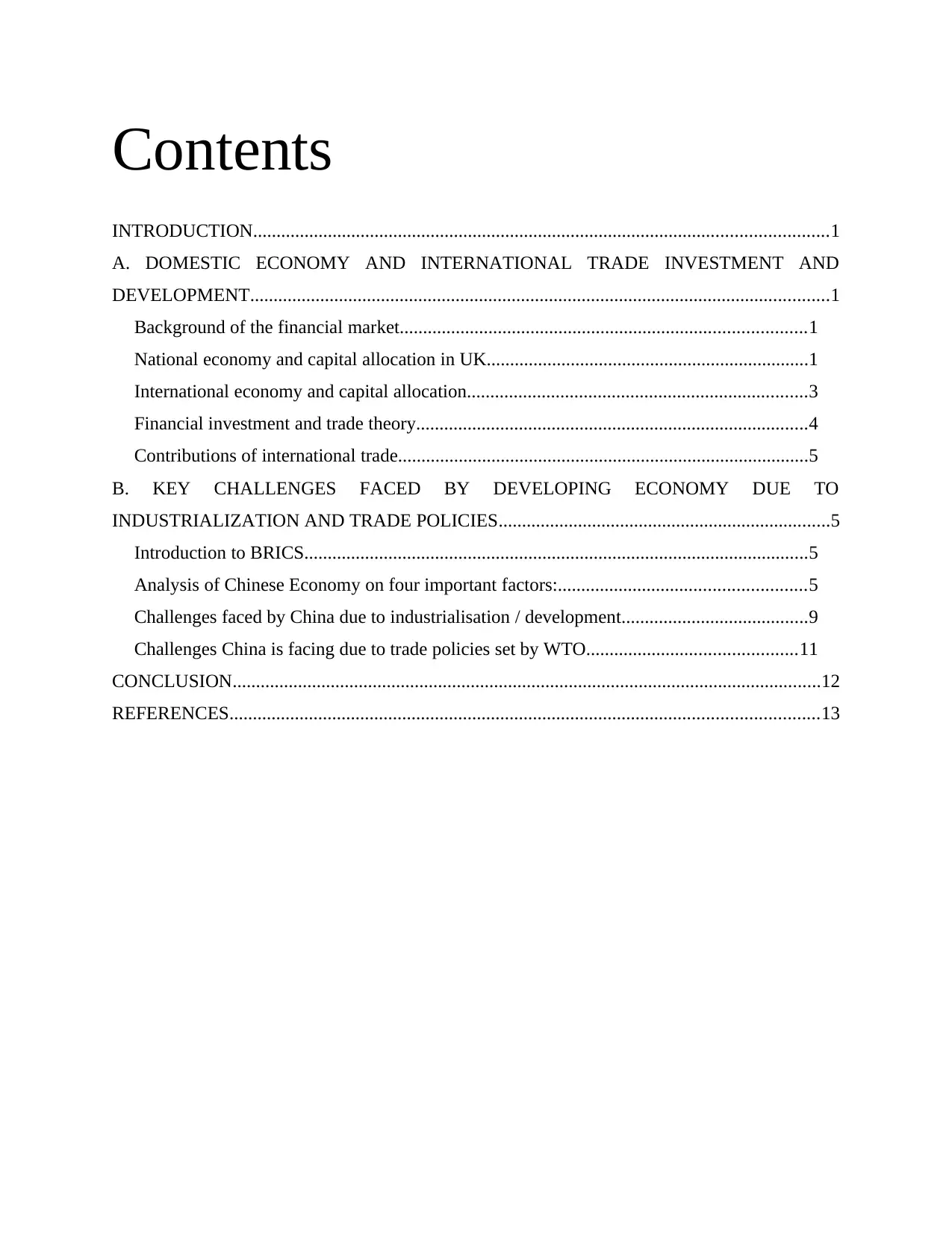
Contents
INTRODUCTION...........................................................................................................................1
A. DOMESTIC ECONOMY AND INTERNATIONAL TRADE INVESTMENT AND
DEVELOPMENT............................................................................................................................1
Background of the financial market.......................................................................................1
National economy and capital allocation in UK.....................................................................1
International economy and capital allocation.........................................................................3
Financial investment and trade theory....................................................................................4
Contributions of international trade........................................................................................5
B. KEY CHALLENGES FACED BY DEVELOPING ECONOMY DUE TO
INDUSTRIALIZATION AND TRADE POLICIES.......................................................................5
Introduction to BRICS............................................................................................................5
Analysis of Chinese Economy on four important factors:.....................................................5
Challenges faced by China due to industrialisation / development........................................9
Challenges China is facing due to trade policies set by WTO.............................................11
CONCLUSION..............................................................................................................................12
REFERENCES..............................................................................................................................13
INTRODUCTION...........................................................................................................................1
A. DOMESTIC ECONOMY AND INTERNATIONAL TRADE INVESTMENT AND
DEVELOPMENT............................................................................................................................1
Background of the financial market.......................................................................................1
National economy and capital allocation in UK.....................................................................1
International economy and capital allocation.........................................................................3
Financial investment and trade theory....................................................................................4
Contributions of international trade........................................................................................5
B. KEY CHALLENGES FACED BY DEVELOPING ECONOMY DUE TO
INDUSTRIALIZATION AND TRADE POLICIES.......................................................................5
Introduction to BRICS............................................................................................................5
Analysis of Chinese Economy on four important factors:.....................................................5
Challenges faced by China due to industrialisation / development........................................9
Challenges China is facing due to trade policies set by WTO.............................................11
CONCLUSION..............................................................................................................................12
REFERENCES..............................................................................................................................13
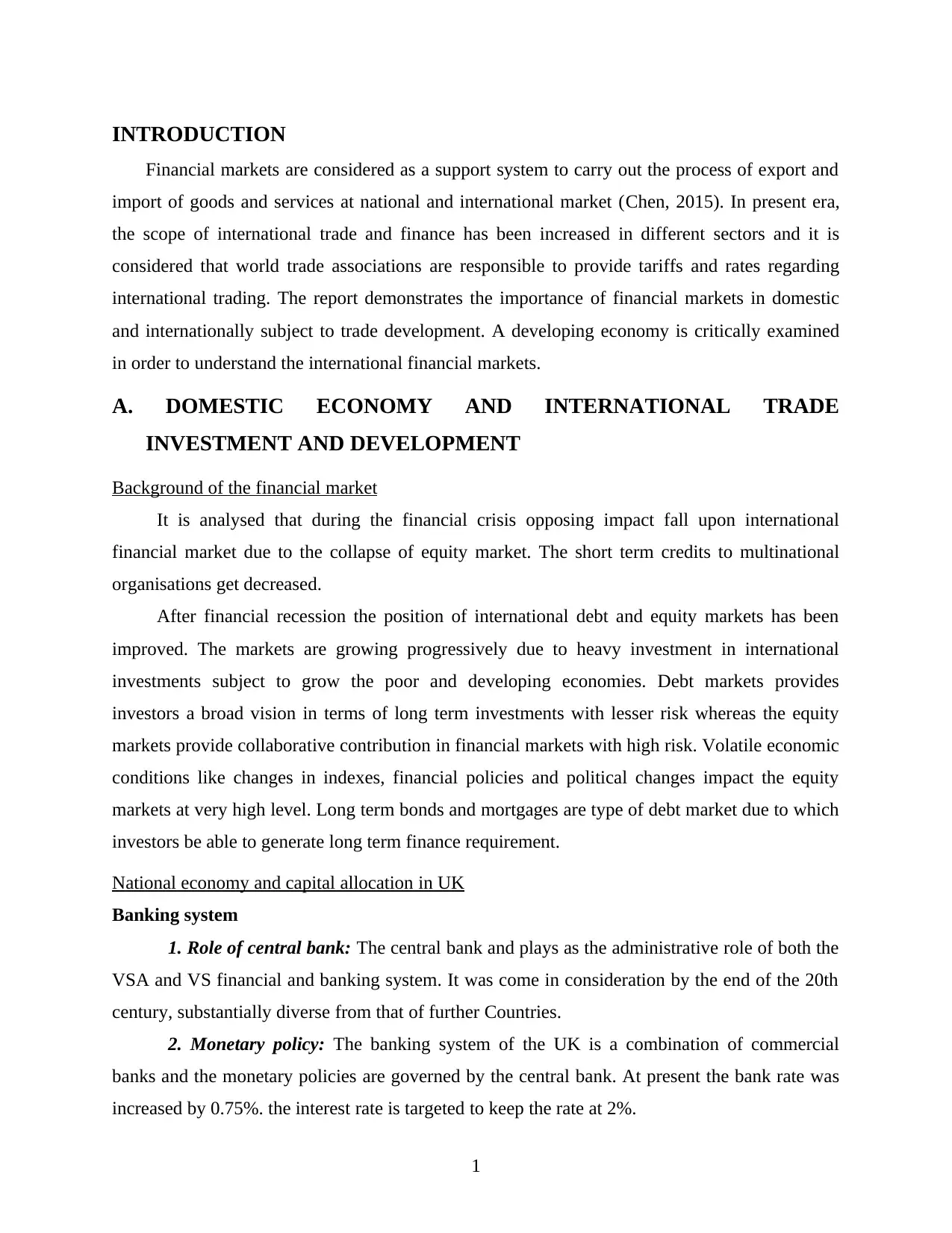
INTRODUCTION
Financial markets are considered as a support system to carry out the process of export and
import of goods and services at national and international market (Chen, 2015). In present era,
the scope of international trade and finance has been increased in different sectors and it is
considered that world trade associations are responsible to provide tariffs and rates regarding
international trading. The report demonstrates the importance of financial markets in domestic
and internationally subject to trade development. A developing economy is critically examined
in order to understand the international financial markets.
A. DOMESTIC ECONOMY AND INTERNATIONAL TRADE
INVESTMENT AND DEVELOPMENT
Background of the financial market
It is analysed that during the financial crisis opposing impact fall upon international
financial market due to the collapse of equity market. The short term credits to multinational
organisations get decreased.
After financial recession the position of international debt and equity markets has been
improved. The markets are growing progressively due to heavy investment in international
investments subject to grow the poor and developing economies. Debt markets provides
investors a broad vision in terms of long term investments with lesser risk whereas the equity
markets provide collaborative contribution in financial markets with high risk. Volatile economic
conditions like changes in indexes, financial policies and political changes impact the equity
markets at very high level. Long term bonds and mortgages are type of debt market due to which
investors be able to generate long term finance requirement.
National economy and capital allocation in UK
Banking system
1. Role of central bank: The central bank and plays as the administrative role of both the
VSA and VS financial and banking system. It was come in consideration by the end of the 20th
century, substantially diverse from that of further Countries.
2. Monetary policy: The banking system of the UK is a combination of commercial
banks and the monetary policies are governed by the central bank. At present the bank rate was
increased by 0.75%. the interest rate is targeted to keep the rate at 2%.
1
Financial markets are considered as a support system to carry out the process of export and
import of goods and services at national and international market (Chen, 2015). In present era,
the scope of international trade and finance has been increased in different sectors and it is
considered that world trade associations are responsible to provide tariffs and rates regarding
international trading. The report demonstrates the importance of financial markets in domestic
and internationally subject to trade development. A developing economy is critically examined
in order to understand the international financial markets.
A. DOMESTIC ECONOMY AND INTERNATIONAL TRADE
INVESTMENT AND DEVELOPMENT
Background of the financial market
It is analysed that during the financial crisis opposing impact fall upon international
financial market due to the collapse of equity market. The short term credits to multinational
organisations get decreased.
After financial recession the position of international debt and equity markets has been
improved. The markets are growing progressively due to heavy investment in international
investments subject to grow the poor and developing economies. Debt markets provides
investors a broad vision in terms of long term investments with lesser risk whereas the equity
markets provide collaborative contribution in financial markets with high risk. Volatile economic
conditions like changes in indexes, financial policies and political changes impact the equity
markets at very high level. Long term bonds and mortgages are type of debt market due to which
investors be able to generate long term finance requirement.
National economy and capital allocation in UK
Banking system
1. Role of central bank: The central bank and plays as the administrative role of both the
VSA and VS financial and banking system. It was come in consideration by the end of the 20th
century, substantially diverse from that of further Countries.
2. Monetary policy: The banking system of the UK is a combination of commercial
banks and the monetary policies are governed by the central bank. At present the bank rate was
increased by 0.75%. the interest rate is targeted to keep the rate at 2%.
1
⊘ This is a preview!⊘
Do you want full access?
Subscribe today to unlock all pages.

Trusted by 1+ million students worldwide
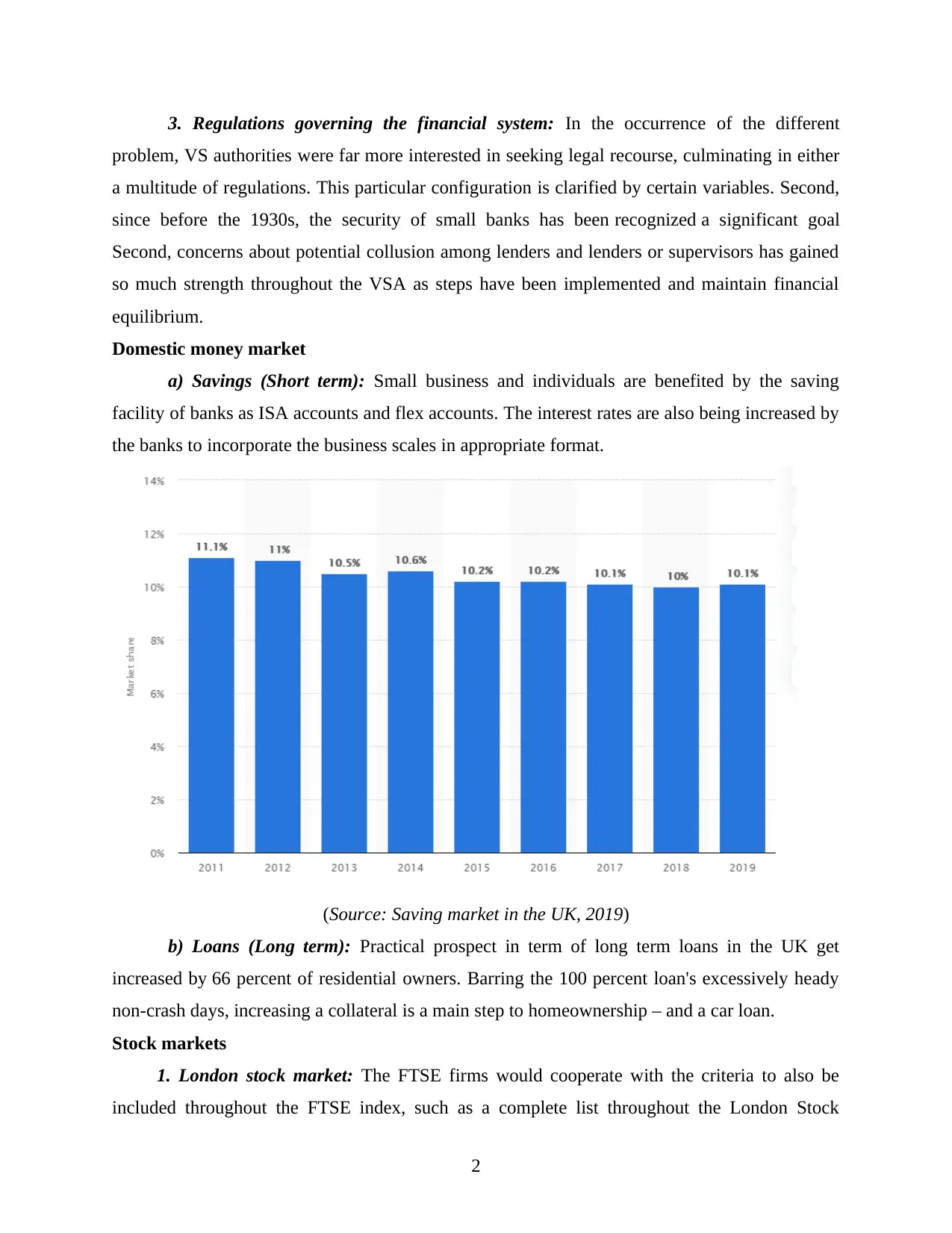
3. Regulations governing the financial system: In the occurrence of the different
problem, VS authorities were far more interested in seeking legal recourse, culminating in either
a multitude of regulations. This particular configuration is clarified by certain variables. Second,
since before the 1930s, the security of small banks has been recognized a significant goal
Second, concerns about potential collusion among lenders and lenders or supervisors has gained
so much strength throughout the VSA as steps have been implemented and maintain financial
equilibrium.
Domestic money market
a) Savings (Short term): Small business and individuals are benefited by the saving
facility of banks as ISA accounts and flex accounts. The interest rates are also being increased by
the banks to incorporate the business scales in appropriate format.
(Source: Saving market in the UK, 2019)
b) Loans (Long term): Practical prospect in term of long term loans in the UK get
increased by 66 percent of residential owners. Barring the 100 percent loan's excessively heady
non-crash days, increasing a collateral is a main step to homeownership – and a car loan.
Stock markets
1. London stock market: The FTSE firms would cooperate with the criteria to also be
included throughout the FTSE index, such as a complete list throughout the London Stock
2
problem, VS authorities were far more interested in seeking legal recourse, culminating in either
a multitude of regulations. This particular configuration is clarified by certain variables. Second,
since before the 1930s, the security of small banks has been recognized a significant goal
Second, concerns about potential collusion among lenders and lenders or supervisors has gained
so much strength throughout the VSA as steps have been implemented and maintain financial
equilibrium.
Domestic money market
a) Savings (Short term): Small business and individuals are benefited by the saving
facility of banks as ISA accounts and flex accounts. The interest rates are also being increased by
the banks to incorporate the business scales in appropriate format.
(Source: Saving market in the UK, 2019)
b) Loans (Long term): Practical prospect in term of long term loans in the UK get
increased by 66 percent of residential owners. Barring the 100 percent loan's excessively heady
non-crash days, increasing a collateral is a main step to homeownership – and a car loan.
Stock markets
1. London stock market: The FTSE firms would cooperate with the criteria to also be
included throughout the FTSE index, such as a complete list throughout the London Stock
2
Paraphrase This Document
Need a fresh take? Get an instant paraphrase of this document with our AI Paraphraser
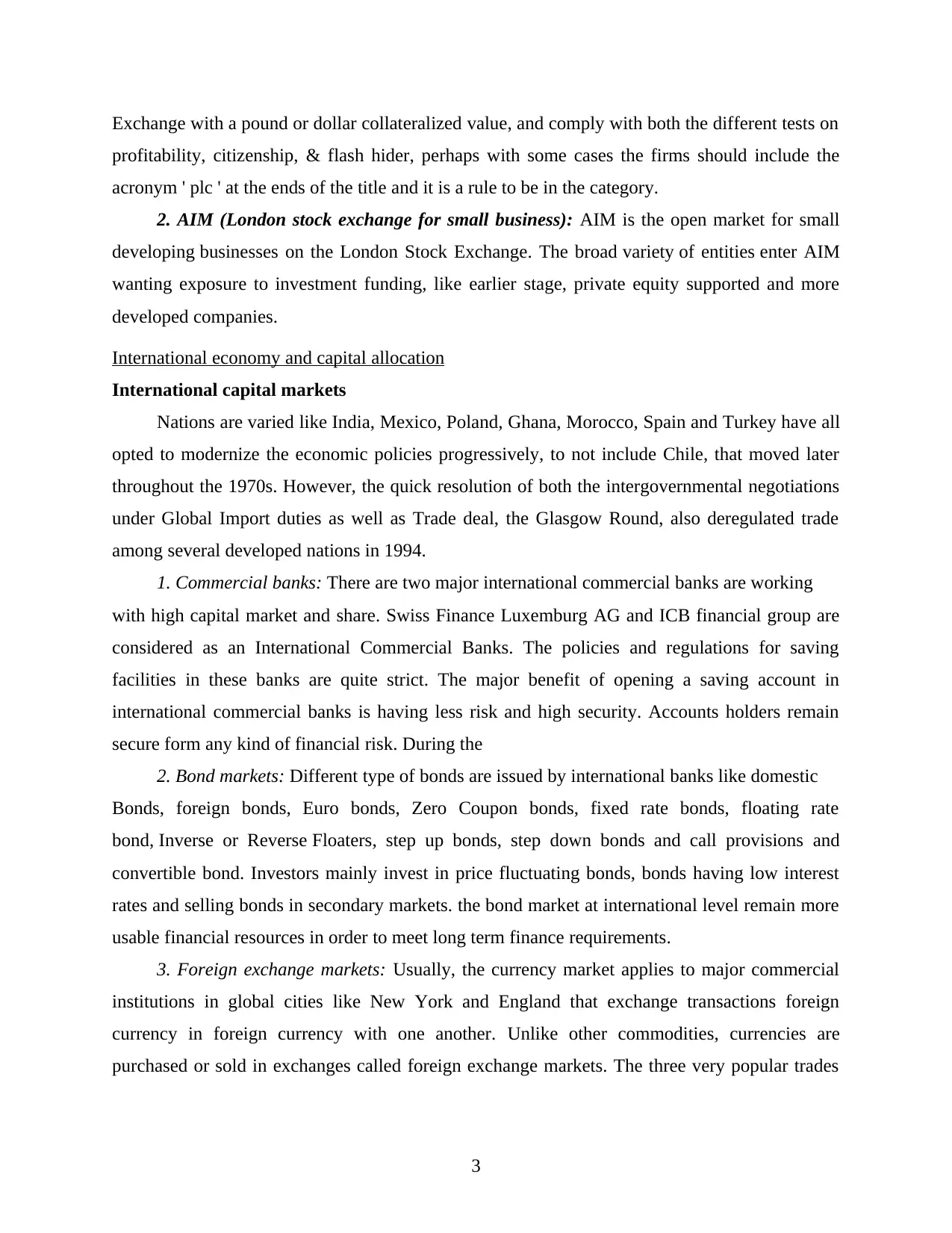
Exchange with a pound or dollar collateralized value, and comply with both the different tests on
profitability, citizenship, & flash hider, perhaps with some cases the firms should include the
acronym ' plc ' at the ends of the title and it is a rule to be in the category.
2. AIM (London stock exchange for small business): AIM is the open market for small
developing businesses on the London Stock Exchange. The broad variety of entities enter AIM
wanting exposure to investment funding, like earlier stage, private equity supported and more
developed companies.
International economy and capital allocation
International capital markets
Nations are varied like India, Mexico, Poland, Ghana, Morocco, Spain and Turkey have all
opted to modernize the economic policies progressively, to not include Chile, that moved later
throughout the 1970s. However, the quick resolution of both the intergovernmental negotiations
under Global Import duties as well as Trade deal, the Glasgow Round, also deregulated trade
among several developed nations in 1994.
1. Commercial banks: There are two major international commercial banks are working
with high capital market and share. Swiss Finance Luxemburg AG and ICB financial group are
considered as an International Commercial Banks. The policies and regulations for saving
facilities in these banks are quite strict. The major benefit of opening a saving account in
international commercial banks is having less risk and high security. Accounts holders remain
secure form any kind of financial risk. During the
2. Bond markets: Different type of bonds are issued by international banks like domestic
Bonds, foreign bonds, Euro bonds, Zero Coupon bonds, fixed rate bonds, floating rate
bond, Inverse or Reverse Floaters, step up bonds, step down bonds and call provisions and
convertible bond. Investors mainly invest in price fluctuating bonds, bonds having low interest
rates and selling bonds in secondary markets. the bond market at international level remain more
usable financial resources in order to meet long term finance requirements.
3. Foreign exchange markets: Usually, the currency market applies to major commercial
institutions in global cities like New York and England that exchange transactions foreign
currency in foreign currency with one another. Unlike other commodities, currencies are
purchased or sold in exchanges called foreign exchange markets. The three very popular trades
3
profitability, citizenship, & flash hider, perhaps with some cases the firms should include the
acronym ' plc ' at the ends of the title and it is a rule to be in the category.
2. AIM (London stock exchange for small business): AIM is the open market for small
developing businesses on the London Stock Exchange. The broad variety of entities enter AIM
wanting exposure to investment funding, like earlier stage, private equity supported and more
developed companies.
International economy and capital allocation
International capital markets
Nations are varied like India, Mexico, Poland, Ghana, Morocco, Spain and Turkey have all
opted to modernize the economic policies progressively, to not include Chile, that moved later
throughout the 1970s. However, the quick resolution of both the intergovernmental negotiations
under Global Import duties as well as Trade deal, the Glasgow Round, also deregulated trade
among several developed nations in 1994.
1. Commercial banks: There are two major international commercial banks are working
with high capital market and share. Swiss Finance Luxemburg AG and ICB financial group are
considered as an International Commercial Banks. The policies and regulations for saving
facilities in these banks are quite strict. The major benefit of opening a saving account in
international commercial banks is having less risk and high security. Accounts holders remain
secure form any kind of financial risk. During the
2. Bond markets: Different type of bonds are issued by international banks like domestic
Bonds, foreign bonds, Euro bonds, Zero Coupon bonds, fixed rate bonds, floating rate
bond, Inverse or Reverse Floaters, step up bonds, step down bonds and call provisions and
convertible bond. Investors mainly invest in price fluctuating bonds, bonds having low interest
rates and selling bonds in secondary markets. the bond market at international level remain more
usable financial resources in order to meet long term finance requirements.
3. Foreign exchange markets: Usually, the currency market applies to major commercial
institutions in global cities like New York and England that exchange transactions foreign
currency in foreign currency with one another. Unlike other commodities, currencies are
purchased or sold in exchanges called foreign exchange markets. The three very popular trades
3
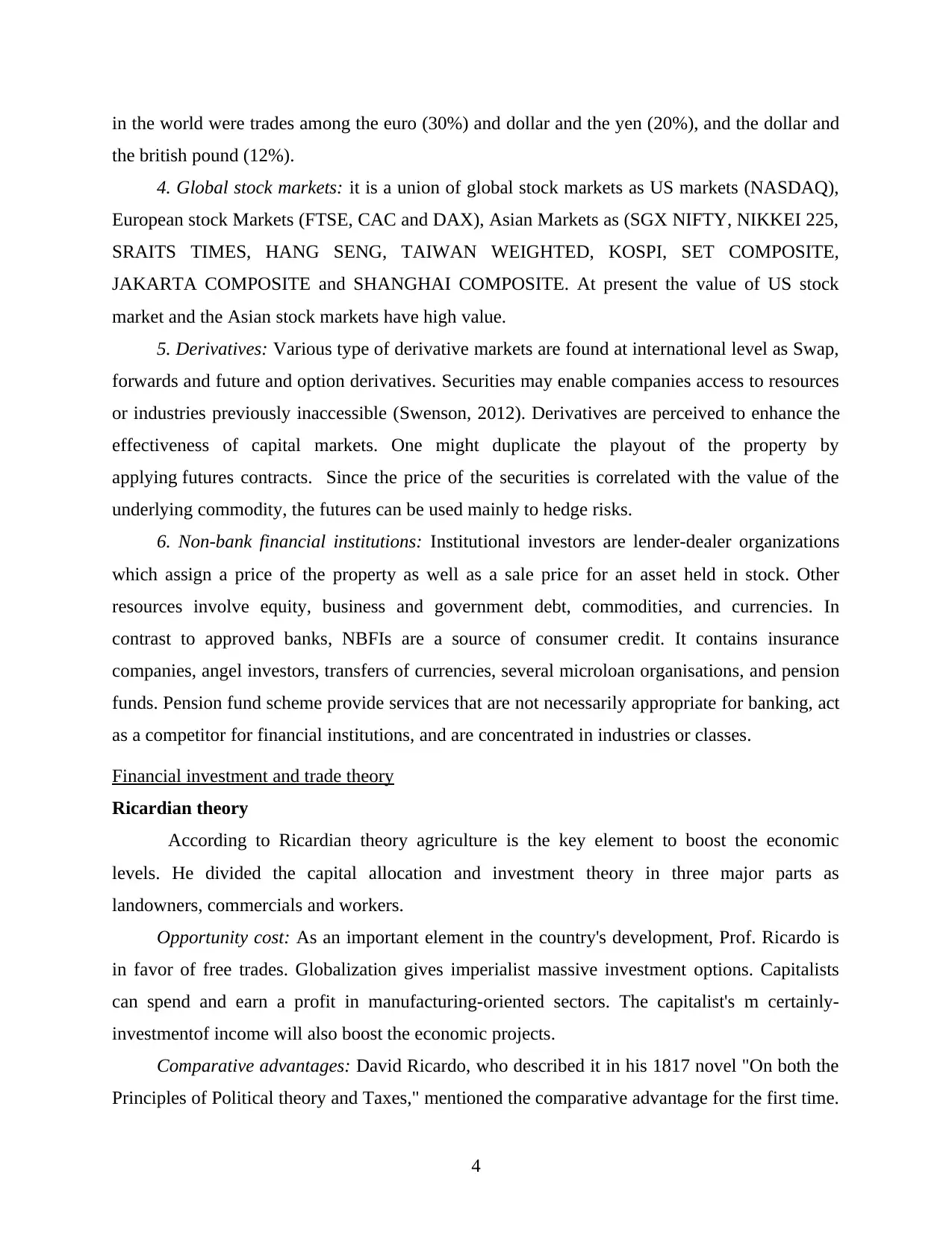
in the world were trades among the euro (30%) and dollar and the yen (20%), and the dollar and
the british pound (12%).
4. Global stock markets: it is a union of global stock markets as US markets (NASDAQ),
European stock Markets (FTSE, CAC and DAX), Asian Markets as (SGX NIFTY, NIKKEI 225,
SRAITS TIMES, HANG SENG, TAIWAN WEIGHTED, KOSPI, SET COMPOSITE,
JAKARTA COMPOSITE and SHANGHAI COMPOSITE. At present the value of US stock
market and the Asian stock markets have high value.
5. Derivatives: Various type of derivative markets are found at international level as Swap,
forwards and future and option derivatives. Securities may enable companies access to resources
or industries previously inaccessible (Swenson, 2012). Derivatives are perceived to enhance the
effectiveness of capital markets. One might duplicate the playout of the property by
applying futures contracts. Since the price of the securities is correlated with the value of the
underlying commodity, the futures can be used mainly to hedge risks.
6. Non-bank financial institutions: Institutional investors are lender-dealer organizations
which assign a price of the property as well as a sale price for an asset held in stock. Other
resources involve equity, business and government debt, commodities, and currencies. In
contrast to approved banks, NBFIs are a source of consumer credit. It contains insurance
companies, angel investors, transfers of currencies, several microloan organisations, and pension
funds. Pension fund scheme provide services that are not necessarily appropriate for banking, act
as a competitor for financial institutions, and are concentrated in industries or classes.
Financial investment and trade theory
Ricardian theory
According to Ricardian theory agriculture is the key element to boost the economic
levels. He divided the capital allocation and investment theory in three major parts as
landowners, commercials and workers.
Opportunity cost: As an important element in the country's development, Prof. Ricardo is
in favor of free trades. Globalization gives imperialist massive investment options. Capitalists
can spend and earn a profit in manufacturing-oriented sectors. The capitalist's m certainly-
investmentof income will also boost the economic projects.
Comparative advantages: David Ricardo, who described it in his 1817 novel "On both the
Principles of Political theory and Taxes," mentioned the comparative advantage for the first time.
4
the british pound (12%).
4. Global stock markets: it is a union of global stock markets as US markets (NASDAQ),
European stock Markets (FTSE, CAC and DAX), Asian Markets as (SGX NIFTY, NIKKEI 225,
SRAITS TIMES, HANG SENG, TAIWAN WEIGHTED, KOSPI, SET COMPOSITE,
JAKARTA COMPOSITE and SHANGHAI COMPOSITE. At present the value of US stock
market and the Asian stock markets have high value.
5. Derivatives: Various type of derivative markets are found at international level as Swap,
forwards and future and option derivatives. Securities may enable companies access to resources
or industries previously inaccessible (Swenson, 2012). Derivatives are perceived to enhance the
effectiveness of capital markets. One might duplicate the playout of the property by
applying futures contracts. Since the price of the securities is correlated with the value of the
underlying commodity, the futures can be used mainly to hedge risks.
6. Non-bank financial institutions: Institutional investors are lender-dealer organizations
which assign a price of the property as well as a sale price for an asset held in stock. Other
resources involve equity, business and government debt, commodities, and currencies. In
contrast to approved banks, NBFIs are a source of consumer credit. It contains insurance
companies, angel investors, transfers of currencies, several microloan organisations, and pension
funds. Pension fund scheme provide services that are not necessarily appropriate for banking, act
as a competitor for financial institutions, and are concentrated in industries or classes.
Financial investment and trade theory
Ricardian theory
According to Ricardian theory agriculture is the key element to boost the economic
levels. He divided the capital allocation and investment theory in three major parts as
landowners, commercials and workers.
Opportunity cost: As an important element in the country's development, Prof. Ricardo is
in favor of free trades. Globalization gives imperialist massive investment options. Capitalists
can spend and earn a profit in manufacturing-oriented sectors. The capitalist's m certainly-
investmentof income will also boost the economic projects.
Comparative advantages: David Ricardo, who described it in his 1817 novel "On both the
Principles of Political theory and Taxes," mentioned the comparative advantage for the first time.
4
⊘ This is a preview!⊘
Do you want full access?
Subscribe today to unlock all pages.

Trusted by 1+ million students worldwide
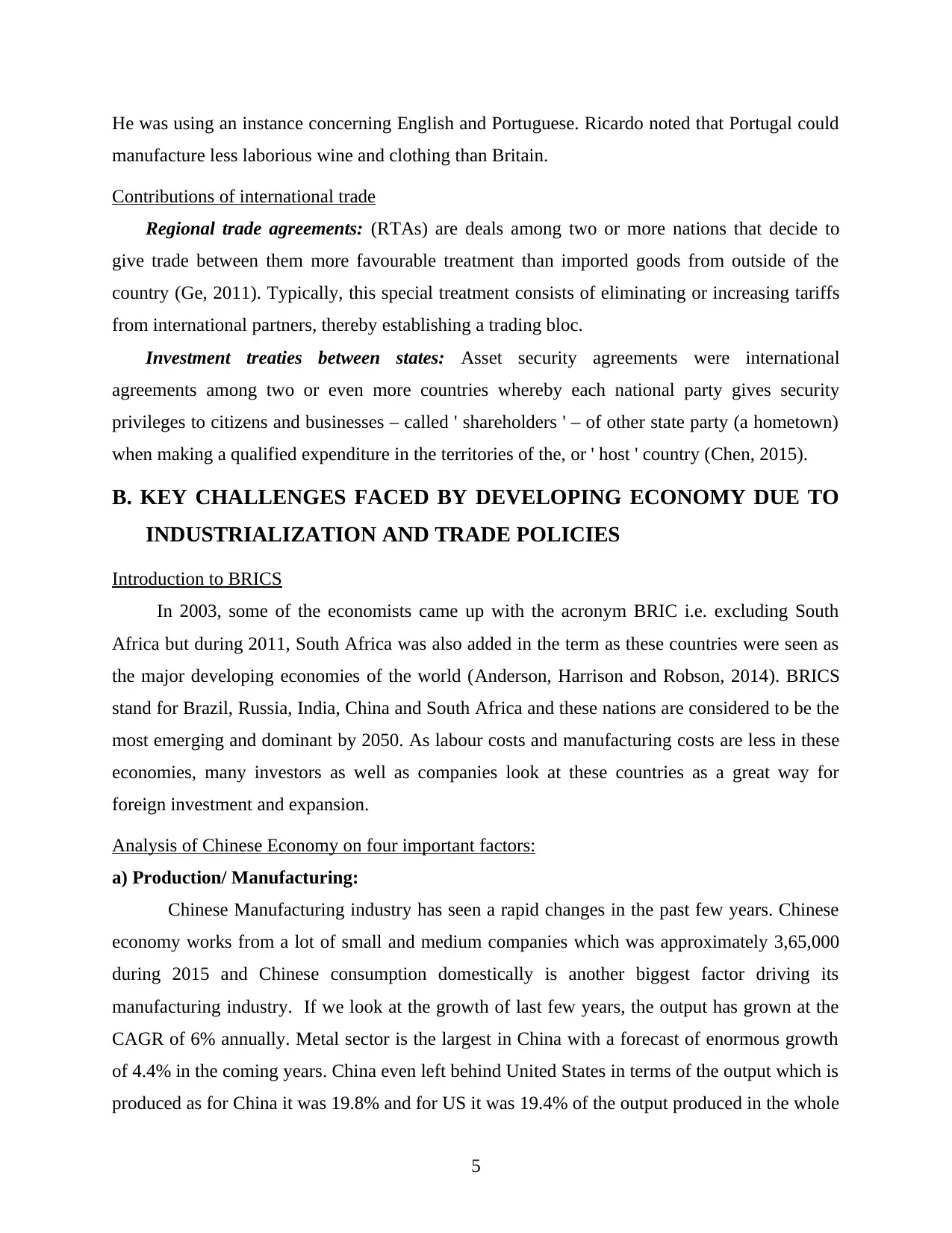
He was using an instance concerning English and Portuguese. Ricardo noted that Portugal could
manufacture less laborious wine and clothing than Britain.
Contributions of international trade
Regional trade agreements: (RTAs) are deals among two or more nations that decide to
give trade between them more favourable treatment than imported goods from outside of the
country (Ge, 2011). Typically, this special treatment consists of eliminating or increasing tariffs
from international partners, thereby establishing a trading bloc.
Investment treaties between states: Asset security agreements were international
agreements among two or even more countries whereby each national party gives security
privileges to citizens and businesses – called ' shareholders ' – of other state party (a hometown)
when making a qualified expenditure in the territories of the, or ' host ' country (Chen, 2015).
B. KEY CHALLENGES FACED BY DEVELOPING ECONOMY DUE TO
INDUSTRIALIZATION AND TRADE POLICIES
Introduction to BRICS
In 2003, some of the economists came up with the acronym BRIC i.e. excluding South
Africa but during 2011, South Africa was also added in the term as these countries were seen as
the major developing economies of the world (Anderson, Harrison and Robson, 2014). BRICS
stand for Brazil, Russia, India, China and South Africa and these nations are considered to be the
most emerging and dominant by 2050. As labour costs and manufacturing costs are less in these
economies, many investors as well as companies look at these countries as a great way for
foreign investment and expansion.
Analysis of Chinese Economy on four important factors:
a) Production/ Manufacturing:
Chinese Manufacturing industry has seen a rapid changes in the past few years. Chinese
economy works from a lot of small and medium companies which was approximately 3,65,000
during 2015 and Chinese consumption domestically is another biggest factor driving its
manufacturing industry. If we look at the growth of last few years, the output has grown at the
CAGR of 6% annually. Metal sector is the largest in China with a forecast of enormous growth
of 4.4% in the coming years. China even left behind United States in terms of the output which is
produced as for China it was 19.8% and for US it was 19.4% of the output produced in the whole
5
manufacture less laborious wine and clothing than Britain.
Contributions of international trade
Regional trade agreements: (RTAs) are deals among two or more nations that decide to
give trade between them more favourable treatment than imported goods from outside of the
country (Ge, 2011). Typically, this special treatment consists of eliminating or increasing tariffs
from international partners, thereby establishing a trading bloc.
Investment treaties between states: Asset security agreements were international
agreements among two or even more countries whereby each national party gives security
privileges to citizens and businesses – called ' shareholders ' – of other state party (a hometown)
when making a qualified expenditure in the territories of the, or ' host ' country (Chen, 2015).
B. KEY CHALLENGES FACED BY DEVELOPING ECONOMY DUE TO
INDUSTRIALIZATION AND TRADE POLICIES
Introduction to BRICS
In 2003, some of the economists came up with the acronym BRIC i.e. excluding South
Africa but during 2011, South Africa was also added in the term as these countries were seen as
the major developing economies of the world (Anderson, Harrison and Robson, 2014). BRICS
stand for Brazil, Russia, India, China and South Africa and these nations are considered to be the
most emerging and dominant by 2050. As labour costs and manufacturing costs are less in these
economies, many investors as well as companies look at these countries as a great way for
foreign investment and expansion.
Analysis of Chinese Economy on four important factors:
a) Production/ Manufacturing:
Chinese Manufacturing industry has seen a rapid changes in the past few years. Chinese
economy works from a lot of small and medium companies which was approximately 3,65,000
during 2015 and Chinese consumption domestically is another biggest factor driving its
manufacturing industry. If we look at the growth of last few years, the output has grown at the
CAGR of 6% annually. Metal sector is the largest in China with a forecast of enormous growth
of 4.4% in the coming years. China even left behind United States in terms of the output which is
produced as for China it was 19.8% and for US it was 19.4% of the output produced in the whole
5
Paraphrase This Document
Need a fresh take? Get an instant paraphrase of this document with our AI Paraphraser
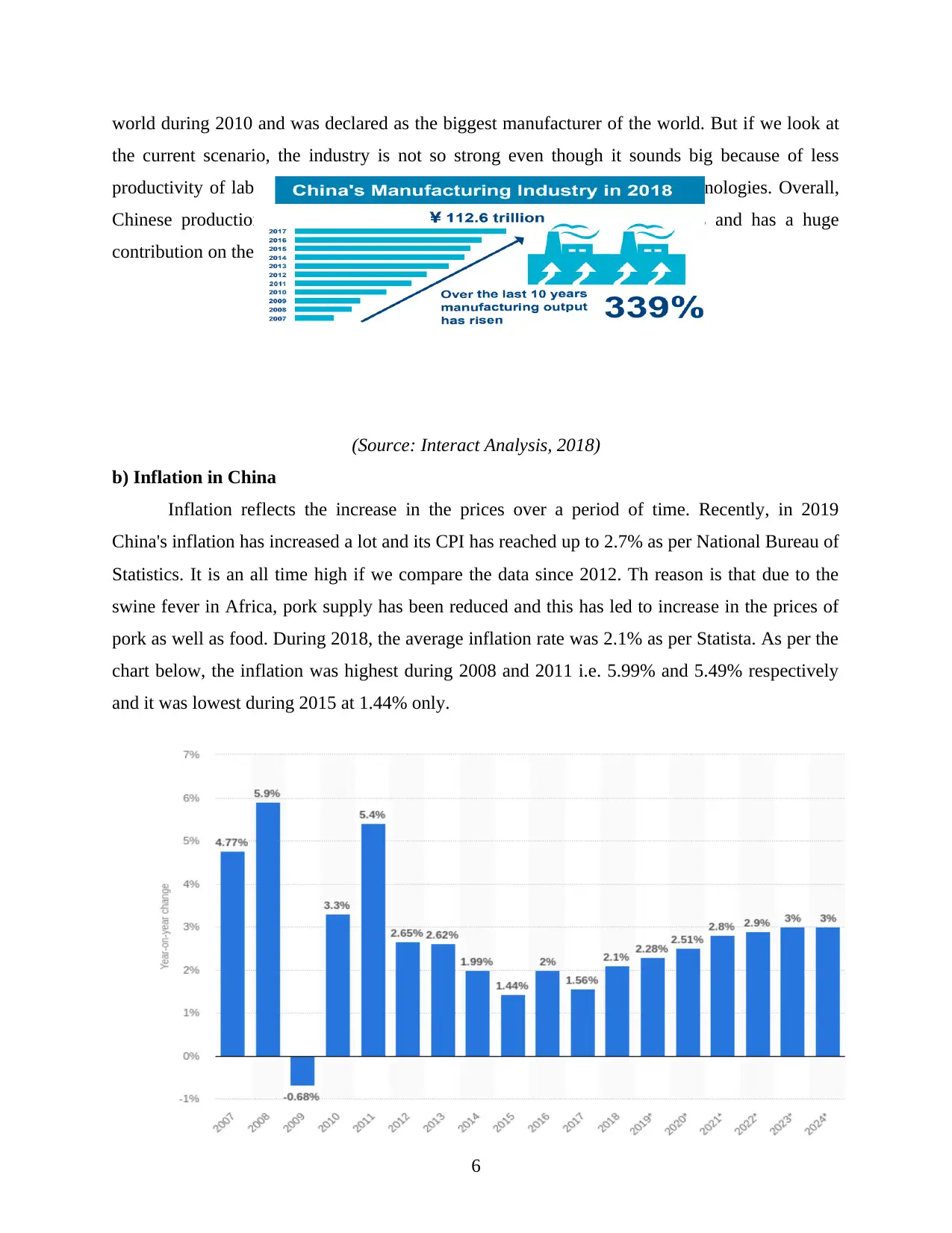
world during 2010 and was declared as the biggest manufacturer of the world. But if we look at
the current scenario, the industry is not so strong even though it sounds big because of less
productivity of labour and higher reliability on imports for the advanced technologies. Overall,
Chinese production sector is going to expand rapidly in the coming years and has a huge
contribution on the economic growth of the world.
(Source: Interact Analysis, 2018)
b) Inflation in China
Inflation reflects the increase in the prices over a period of time. Recently, in 2019
China's inflation has increased a lot and its CPI has reached up to 2.7% as per National Bureau of
Statistics. It is an all time high if we compare the data since 2012. Th reason is that due to the
swine fever in Africa, pork supply has been reduced and this has led to increase in the prices of
pork as well as food. During 2018, the average inflation rate was 2.1% as per Statista. As per the
chart below, the inflation was highest during 2008 and 2011 i.e. 5.99% and 5.49% respectively
and it was lowest during 2015 at 1.44% only.
Average inflation rate in China from 2007-2024
6
the current scenario, the industry is not so strong even though it sounds big because of less
productivity of labour and higher reliability on imports for the advanced technologies. Overall,
Chinese production sector is going to expand rapidly in the coming years and has a huge
contribution on the economic growth of the world.
(Source: Interact Analysis, 2018)
b) Inflation in China
Inflation reflects the increase in the prices over a period of time. Recently, in 2019
China's inflation has increased a lot and its CPI has reached up to 2.7% as per National Bureau of
Statistics. It is an all time high if we compare the data since 2012. Th reason is that due to the
swine fever in Africa, pork supply has been reduced and this has led to increase in the prices of
pork as well as food. During 2018, the average inflation rate was 2.1% as per Statista. As per the
chart below, the inflation was highest during 2008 and 2011 i.e. 5.99% and 5.49% respectively
and it was lowest during 2015 at 1.44% only.
Average inflation rate in China from 2007-2024
6
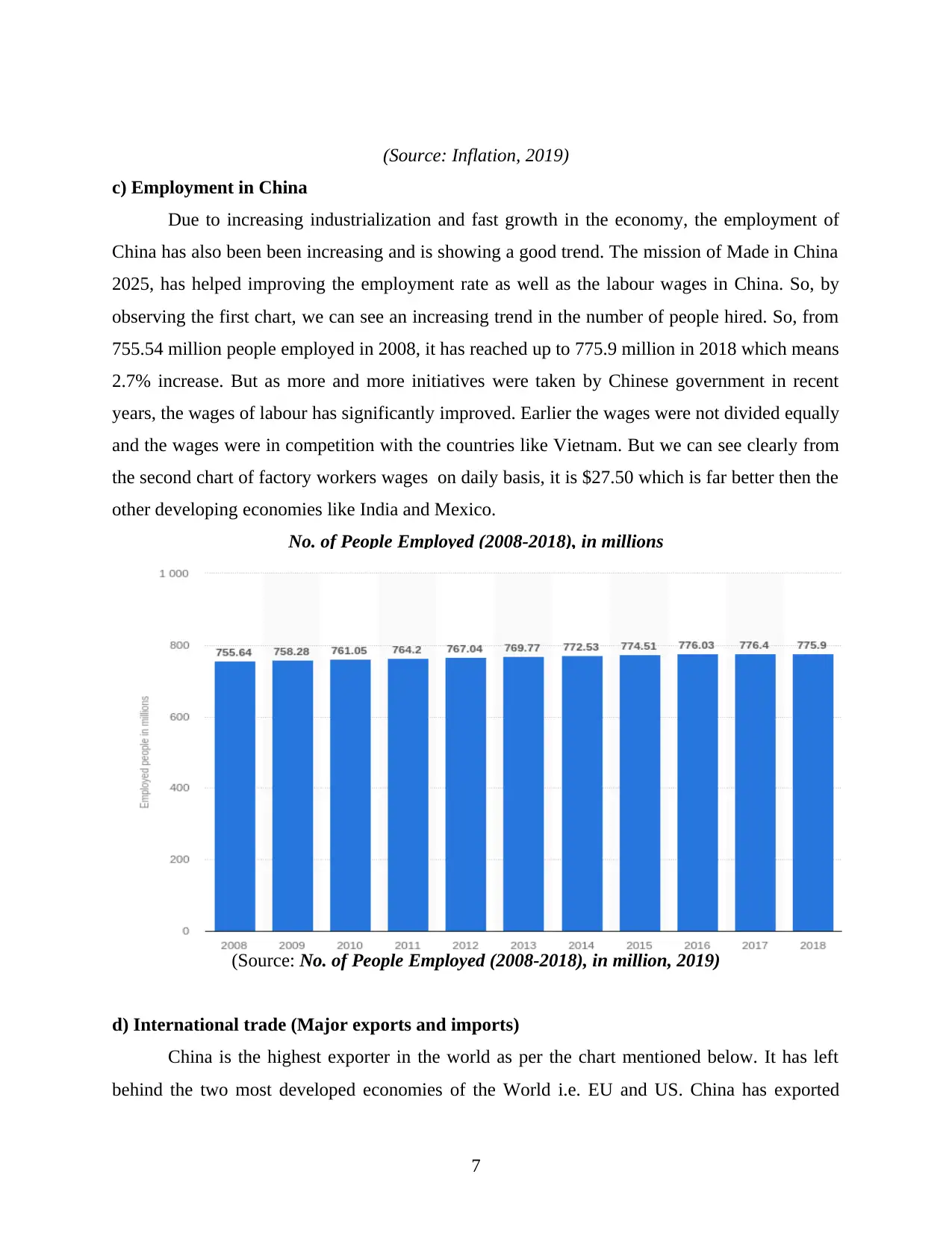
(Source: Inflation, 2019)
c) Employment in China
Due to increasing industrialization and fast growth in the economy, the employment of
China has also been been increasing and is showing a good trend. The mission of Made in China
2025, has helped improving the employment rate as well as the labour wages in China. So, by
observing the first chart, we can see an increasing trend in the number of people hired. So, from
755.54 million people employed in 2008, it has reached up to 775.9 million in 2018 which means
2.7% increase. But as more and more initiatives were taken by Chinese government in recent
years, the wages of labour has significantly improved. Earlier the wages were not divided equally
and the wages were in competition with the countries like Vietnam. But we can see clearly from
the second chart of factory workers wages on daily basis, it is $27.50 which is far better then the
other developing economies like India and Mexico.
No. of People Employed (2008-2018), in millions
(Source: No. of People Employed (2008-2018), in million, 2019)
d) International trade (Major exports and imports)
China is the highest exporter in the world as per the chart mentioned below. It has left
behind the two most developed economies of the World i.e. EU and US. China has exported
7
c) Employment in China
Due to increasing industrialization and fast growth in the economy, the employment of
China has also been been increasing and is showing a good trend. The mission of Made in China
2025, has helped improving the employment rate as well as the labour wages in China. So, by
observing the first chart, we can see an increasing trend in the number of people hired. So, from
755.54 million people employed in 2008, it has reached up to 775.9 million in 2018 which means
2.7% increase. But as more and more initiatives were taken by Chinese government in recent
years, the wages of labour has significantly improved. Earlier the wages were not divided equally
and the wages were in competition with the countries like Vietnam. But we can see clearly from
the second chart of factory workers wages on daily basis, it is $27.50 which is far better then the
other developing economies like India and Mexico.
No. of People Employed (2008-2018), in millions
(Source: No. of People Employed (2008-2018), in million, 2019)
d) International trade (Major exports and imports)
China is the highest exporter in the world as per the chart mentioned below. It has left
behind the two most developed economies of the World i.e. EU and US. China has exported
7
⊘ This is a preview!⊘
Do you want full access?
Subscribe today to unlock all pages.

Trusted by 1+ million students worldwide
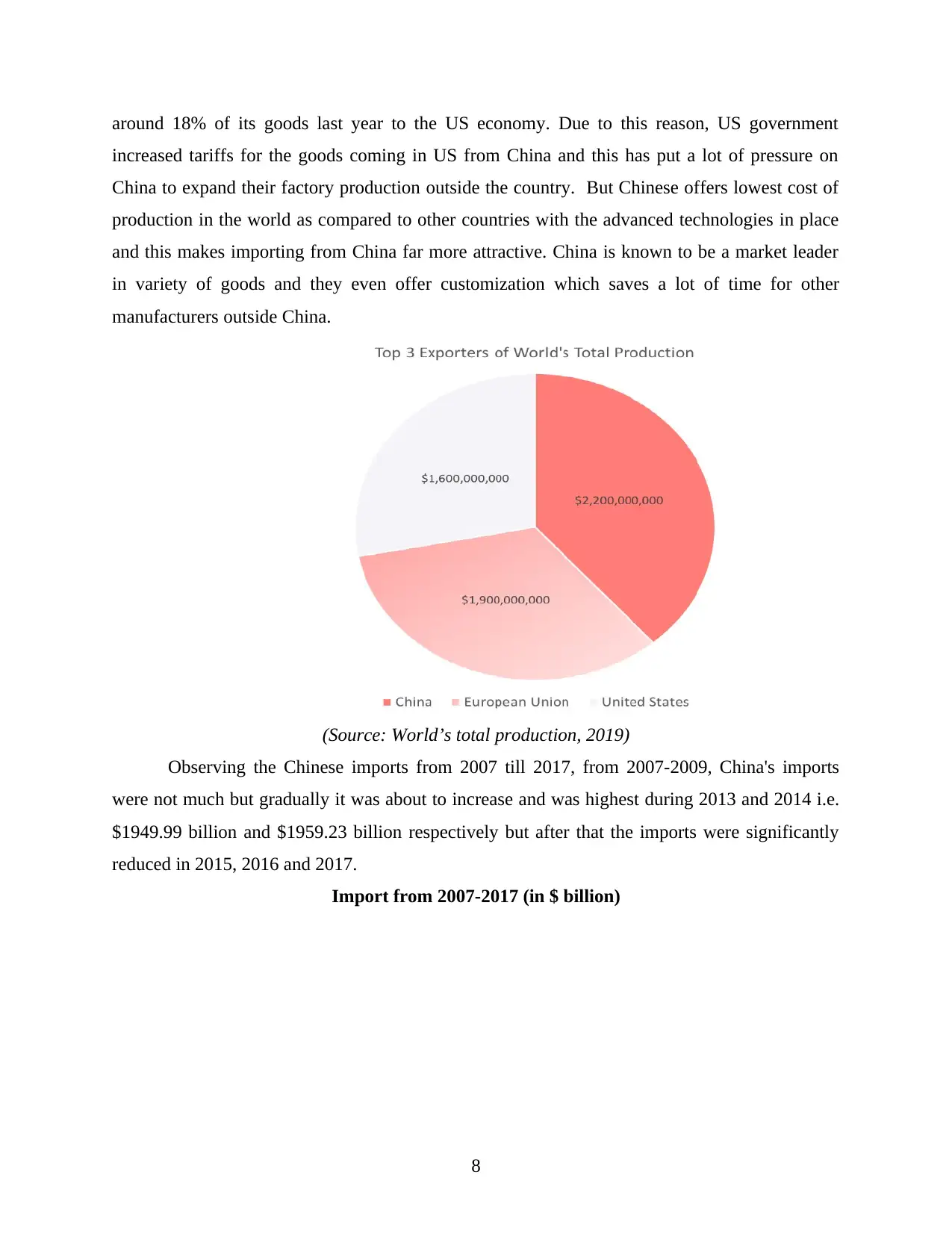
around 18% of its goods last year to the US economy. Due to this reason, US government
increased tariffs for the goods coming in US from China and this has put a lot of pressure on
China to expand their factory production outside the country. But Chinese offers lowest cost of
production in the world as compared to other countries with the advanced technologies in place
and this makes importing from China far more attractive. China is known to be a market leader
in variety of goods and they even offer customization which saves a lot of time for other
manufacturers outside China.
S
(Source: World’s total production, 2019)
Observing the Chinese imports from 2007 till 2017, from 2007-2009, China's imports
were not much but gradually it was about to increase and was highest during 2013 and 2014 i.e.
$1949.99 billion and $1959.23 billion respectively but after that the imports were significantly
reduced in 2015, 2016 and 2017.
Import from 2007-2017 (in $ billion)
8
increased tariffs for the goods coming in US from China and this has put a lot of pressure on
China to expand their factory production outside the country. But Chinese offers lowest cost of
production in the world as compared to other countries with the advanced technologies in place
and this makes importing from China far more attractive. China is known to be a market leader
in variety of goods and they even offer customization which saves a lot of time for other
manufacturers outside China.
S
(Source: World’s total production, 2019)
Observing the Chinese imports from 2007 till 2017, from 2007-2009, China's imports
were not much but gradually it was about to increase and was highest during 2013 and 2014 i.e.
$1949.99 billion and $1959.23 billion respectively but after that the imports were significantly
reduced in 2015, 2016 and 2017.
Import from 2007-2017 (in $ billion)
8
Paraphrase This Document
Need a fresh take? Get an instant paraphrase of this document with our AI Paraphraser
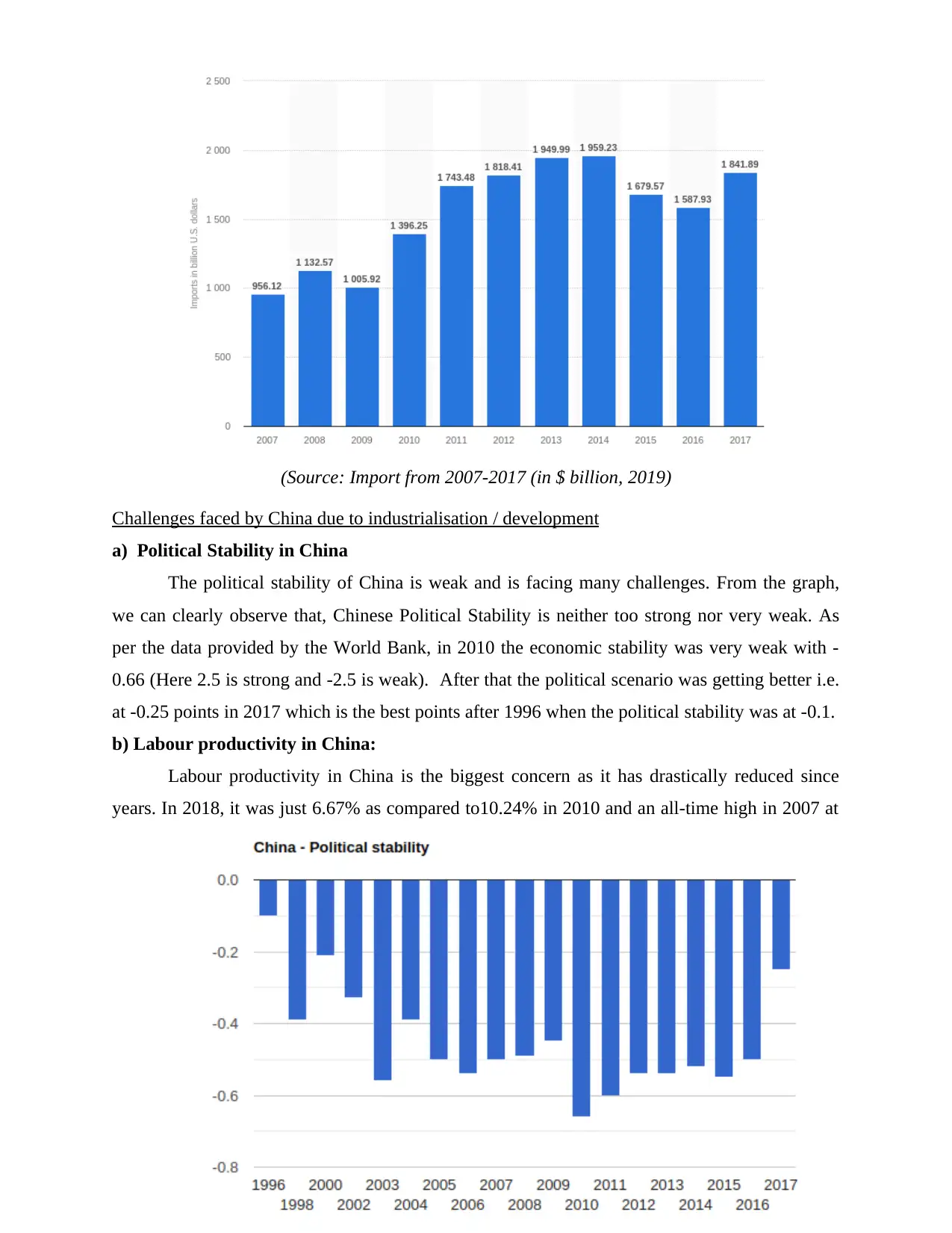
(Source: Import from 2007-2017 (in $ billion, 2019)
Challenges faced by China due to industrialisation / development
a) Political Stability in China
The political stability of China is weak and is facing many challenges. From the graph,
we can clearly observe that, Chinese Political Stability is neither too strong nor very weak. As
per the data provided by the World Bank, in 2010 the economic stability was very weak with -
0.66 (Here 2.5 is strong and -2.5 is weak). After that the political scenario was getting better i.e.
at -0.25 points in 2017 which is the best points after 1996 when the political stability was at -0.1.
b) Labour productivity in China:
Labour productivity in China is the biggest concern as it has drastically reduced since
years. In 2018, it was just 6.67% as compared to10.24% in 2010 and an all-time high in 2007 at
9
Challenges faced by China due to industrialisation / development
a) Political Stability in China
The political stability of China is weak and is facing many challenges. From the graph,
we can clearly observe that, Chinese Political Stability is neither too strong nor very weak. As
per the data provided by the World Bank, in 2010 the economic stability was very weak with -
0.66 (Here 2.5 is strong and -2.5 is weak). After that the political scenario was getting better i.e.
at -0.25 points in 2017 which is the best points after 1996 when the political stability was at -0.1.
b) Labour productivity in China:
Labour productivity in China is the biggest concern as it has drastically reduced since
years. In 2018, it was just 6.67% as compared to10.24% in 2010 and an all-time high in 2007 at
9
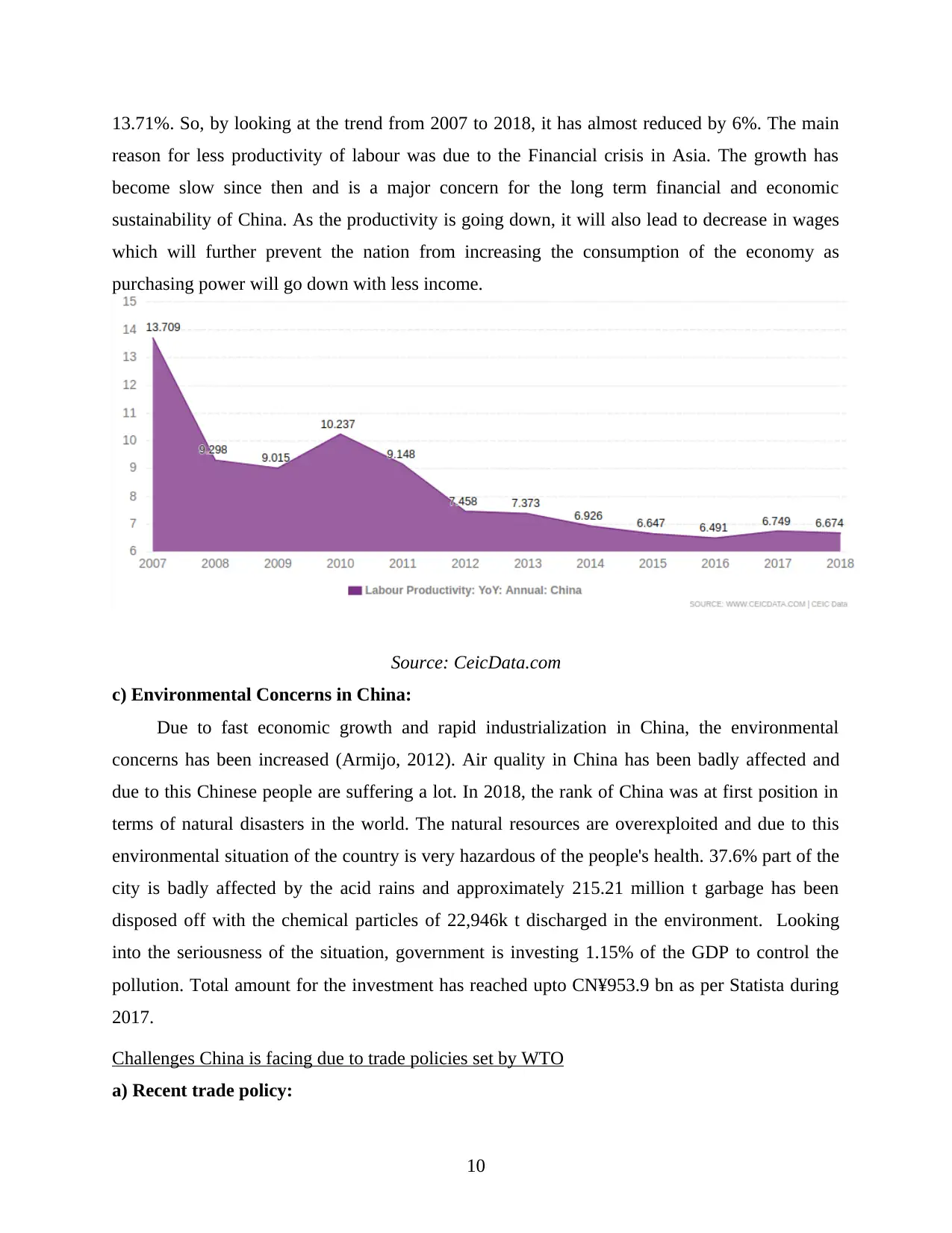
13.71%. So, by looking at the trend from 2007 to 2018, it has almost reduced by 6%. The main
reason for less productivity of labour was due to the Financial crisis in Asia. The growth has
become slow since then and is a major concern for the long term financial and economic
sustainability of China. As the productivity is going down, it will also lead to decrease in wages
which will further prevent the nation from increasing the consumption of the economy as
purchasing power will go down with less income.
Source: CeicData.com
c) Environmental Concerns in China:
Due to fast economic growth and rapid industrialization in China, the environmental
concerns has been increased (Armijo, 2012). Air quality in China has been badly affected and
due to this Chinese people are suffering a lot. In 2018, the rank of China was at first position in
terms of natural disasters in the world. The natural resources are overexploited and due to this
environmental situation of the country is very hazardous of the people's health. 37.6% part of the
city is badly affected by the acid rains and approximately 215.21 million t garbage has been
disposed off with the chemical particles of 22,946k t discharged in the environment. Looking
into the seriousness of the situation, government is investing 1.15% of the GDP to control the
pollution. Total amount for the investment has reached upto CN¥953.9 bn as per Statista during
2017.
Challenges China is facing due to trade policies set by WTO
a) Recent trade policy:
10
reason for less productivity of labour was due to the Financial crisis in Asia. The growth has
become slow since then and is a major concern for the long term financial and economic
sustainability of China. As the productivity is going down, it will also lead to decrease in wages
which will further prevent the nation from increasing the consumption of the economy as
purchasing power will go down with less income.
Source: CeicData.com
c) Environmental Concerns in China:
Due to fast economic growth and rapid industrialization in China, the environmental
concerns has been increased (Armijo, 2012). Air quality in China has been badly affected and
due to this Chinese people are suffering a lot. In 2018, the rank of China was at first position in
terms of natural disasters in the world. The natural resources are overexploited and due to this
environmental situation of the country is very hazardous of the people's health. 37.6% part of the
city is badly affected by the acid rains and approximately 215.21 million t garbage has been
disposed off with the chemical particles of 22,946k t discharged in the environment. Looking
into the seriousness of the situation, government is investing 1.15% of the GDP to control the
pollution. Total amount for the investment has reached upto CN¥953.9 bn as per Statista during
2017.
Challenges China is facing due to trade policies set by WTO
a) Recent trade policy:
10
⊘ This is a preview!⊘
Do you want full access?
Subscribe today to unlock all pages.

Trusted by 1+ million students worldwide
1 out of 15
Related Documents
Your All-in-One AI-Powered Toolkit for Academic Success.
+13062052269
info@desklib.com
Available 24*7 on WhatsApp / Email
![[object Object]](/_next/static/media/star-bottom.7253800d.svg)
Unlock your academic potential
Copyright © 2020–2025 A2Z Services. All Rights Reserved. Developed and managed by ZUCOL.





